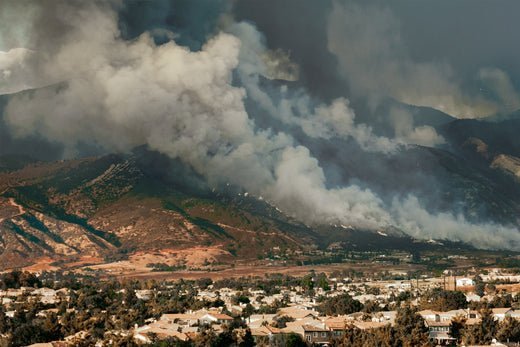
Understanding the Impact of Wildfire Smoke
|
Time to read 2 min
|
Time to read 2 min
Did you know that wildfire smoke can travel for hundreds of miles? According to the National Weather Service, smoke from the 2020 California wildfires rose into the atmospheric jet stream and traveled all the way to the East Coast. In some areas, there was even enough smoke to partially obscure the sun and lower the air temperature. During a study through Climate Central, scientists found that cities within 50–100 miles of active wildfires could experience 5–15 times worse air quality ratings than normal.
As wildfires occur more frequently around the world, we wanted to gather information on the danger they pose to your health and how you can protect yourself.
Smoke may look like an amorphous gray cloud, but it’s far from harmless. To fully understand the impact of wildfire smoke, you need to know what it contains. PM2.5 particulate matter is defined by the EPA as fine, inhalable particles that are 2.5 microns or smaller. To put that into perspective, imagine the size of a grain of sand—that tiny grain is typically 90 microns in diameter, making it 36x larger than a PM2.5 particle.
Wildfire smoke can contain particulates like ash and soot, inorganic compounds like ammonium sulfate, biological materials such as mold spores and pollen, as well as CO₂, CO, and NO₂, none of which are beneficial for your respiratory system.
If you’ve ever gathered around a bonfire for hot dogs and s’mores, you know how it feels to get a face full of smoke. You cough, your eyes sting a little, and you dart out of the way. While it's easy to move away from a bonfire, it’s not so easy to avoid a wildfire that has spread across hundreds of acres. Wildfire smoke can also quickly reduce the air quality in your immediate area; if you’re near an active wildfire, be sure to regularly check the Air Quality Index (AQI).
These issues can easily impact daily living, adding interruptions to the activities you enjoy and use to relax.
Wildfire smoke is a big problem, but there are little steps you can take that make a world of difference for your peace of mind.
For example, have you ever considered creating a “clean air haven” in your home? This is a room that receives special attention and air quality protection. It's as simple as closing the windows, running an air purifier, and keeping that room free of dust, pet dander, etc. Having a room dedicated to having cleaner air than the rest of your home can give you a safe place to breathe when your environment’s air quality is low, while being easier to maintain than trying to keep the air of your entire home as clean.
For more preparedness tips, read our Tips to Help Protect Yourself from Wildfire Smoke blog post.
The Levoit Vital 200S Smart Air Purifier can help keep your home’s atmosphere fresh, regardless of what’s happening outside. With 3-stage filtration, smart control, and customizable scheduling, you can enter any season with better confidence in your home’s indoor air quality.
Important Note
The information provided here is for informational and educational purposes only and should not be used in medical emergencies or for diagnosing or treating any medical condition. It's crucial to consult a licensed medical professional for diagnosis and treatment. External links are for informational purposes and do not constitute endorsements. No warranty of any kind, either expressed or implied, is made as to the products and/or the accuracy, reliability, timeliness, or correctness of the information provided herein.
Sources
EPA - Health Effects Attributed to Wildfire Smoke


